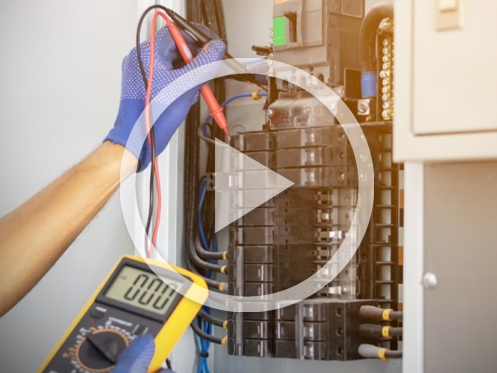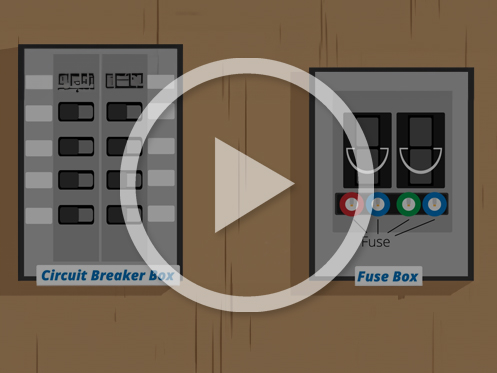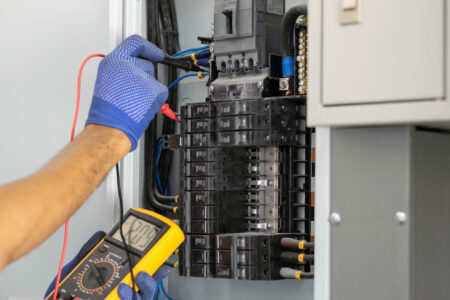Updated January 18, 2024
In the modern world, we rely heavily on electricity. At home, we run computers, TVs, washers, dryers, refrigerators, and other appliances daily. All these things are possible because of the many wires and cables going through our walls. These wires and cables carry the electricity to where we need it and help us live our daily lives. This guide will review the eight main electrical wires and cables commonly found in residential homes. It is essential to allow a trained electrician to do the wiring in your home to prevent injury and fires from occurring.
What Are Electrical Wires and Cables?
Before discussing the different types of wiring, we must understand their components and functions. Electrical wires typically consist of copper or aluminum, which conduct electricity. Nonconductive plastic coatings insulate these wires. A cable contains multiple wires housed in a plastic coating or sheath, while a wire is a single unit. Homes commonly have several types of wiring.
Nonmetallic (NM) Cables
Nonmetallic, or NM, cables are the most commonly found in modern homes, which are significantly drier locations. They comprise three types of wiring in a single sheath: one or more current-carrying wires, a neutral wire, and a ground wire. You can use these for all your outlets, fixtures, and light switches. They are often color-coded to tell the difference between gauges and amps used. They are usually flat and tubular and run through your walls.
Armored Cables
Armored cables (AC), or BX wiring, are sometimes used when local codes prohibit NM cables. Flexible metal sheaths these wires, providing better protection. Electricians have used them since the early 1900s. However, builders cannot use them in buildings with more than three floors; they are also more expensive.
Metal-Clad Cables
A common type of wiring found in the basement and other exposed or unfinished places in your home is the metal-clad or MC cable. These are also housed in metal and are sturdier than NM cables.
THHN/THWN Wires
THHN or THWN wires are the most common insulated cables in your home. Electricians often use them for shorter circuits, such as those for water heaters or garbage disposals. You can also find them in your basement and garage. The letters stand for “thermoplastic heat-resistant nylon-coated.” And the “W” means it is safe to use in wet locations. The nylon coating offers extra protection to the wire. Three wires work together: a hot wire, which is black, orange, or red; a neutral wire, which is white or brown; and a ground wire, which is green or yellow-green. Since these wires are part of a circuit when turned on, touching these wires is dangerous.
Underground Feeder Cables
Electricians often install underground feeder (UF) cables to bring electricity to garages or sheds not attached to your house. They also install these cables for outdoor lighting, such as lampposts. Like NM cables, UF cables feature a plastic sheath, but each of the three cables also has a plastic coating. This helps add extra protection from moisture and sunlight and being underground. The outer sheath is usually gray. These cables are also often used for significant circuit wiring, so they are very dangerous to touch when the circuit is on because of their high voltage.
Low-Voltage Wires
Electricians often use low-voltage wires for smaller circuits that require up to 50 volts. You will usually find them in doorbells, landscape lighting, thermostats, speakers, and anspeakerskler systems. These wires are often insulated or twisted together like a lamp cord in pairs. Since they have a lower voltage, it is less likely to cause a shock, but it is still a good idea to shut them off before working on them.
Landline Phones and Data Wires
If you still have a landline phone, it likely uses a Cat 5 cable. You also use these cables for your wired internet service. These cables generally have eight wires housed in them, combined into four pairs, which provide excellent capacity and quality for data transmission. They are also low-voltage; however, it is good not to touch bare wires regardless of voltage.
Coaxial Cables
Coaxial cables used to be more common, but nowadays, things like HDMI are slowly replacing them. However, they are sometimes used to connect your television to your cable or satellite service and the internet. They are round and consist of a copper conductor wire surrounded by a tubular insulated layer and a conducting shield comprised of braided wire sheathed or jacketed in a cable.
Wire and Cable Identification
You can identify different wires and cables by size and color. The gauge measures the size of a wire and tells you how much electricity it conducts—the most common gauges in your home range from two-gauge to 14-gauge. Bigger wires have smaller gauges and can conduct more electricity. Wires are often color-coded to help you and your electrician more easily identify them. Black and red are usually “hot” wires that conduct electricity to your outlets and switches. Blue and yellow are “travel wires” that control fans, appliances, lights, and switches. White and gray are often neutral wires that help the electrical current circulate. Green or copper wires are grounding wires, making an electrical fire less likely to occur.
Electrical Safety in Your Home
If you look at an outlet in your bathroom or kitchen, you will often find red and black buttons between the two plug-ins. These are GFCIs, which stand for “ground fault circuit interrupter.” They help prevent severe electrical shocks and burns by shutting off your power before it can give off fatal doses of electricity. They can also help prevent and mitigate electrical fires. Your electrician can install these on your outlets or a power cord.
Always ensure your exposed cords, wires, and cables are not damaged. If you notice any fraying or cracks, call us, and we will send an expert electrician to inspect them. Scheduling routine maintenance is a meaningful way to prevent fires and other damage from occurring.
Your Trusted Electricians
At Golden Rule, we have served our customers in the Metro for over 25 years. We offer electrical, HVAC, and plumbing services. We have over 50 vehicles and many licensed and highly trained electricians, HVAC technicians, and plumbers at your service. We are family-owned and offer all our customers a 100% satisfaction guarantee. We strive to treat you the way we want to be treated and provide fast, personal, and efficient service. Contact Golden Rule today for more information about electrical wiring!
Contact Us Today for Electrical Service!
If you found this post helpful, check out some other budget-saving tips:



